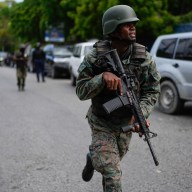BRAMPTON, Ont. – A massive explosion meant to simulate the destructive power a homegrown terrorist group planned to unleash on Canadian targets was among the images released Tuesday as a judge made video evidence public in the prosecutions of the so-called Toronto 18.
The RCMP’s demonstration of just what kind of damage a truck bomb made with ammonium nitrate would cause was among a dozen videos that were to be introduced as evidence at the trial of Zakaria Amara, who pleaded guilty this month to his leadership role in the plot.
Officers detonated a one-tonne ammonium nitrate bomb in a barren field populated with a handful of small structures. What appears to be a large, metal storage container is send tumbling across the field as a ball of fire erupts.
In a slow motion version, a shockwave can be seen travelling outward from the blast.
“The test blast videotapes provide visual evidence of the magnitude of an explosion that might have occurred,” Justice Bruce Durno writes in his decision to release the evidence.
“None of the accused who are awaiting trial raised any objection to the release of the items,” he added.
Another video shows Saad Gaya and Saad Khalid, who have also pleaded guilty, unloading bags labelled “ammonium nitrate” from a truck driven by an undercover police officer. It documents their dramatic arrest just moments later, with five heavily armed officers forcing them to the ground.
The dancing wires of a bomb detonator are also caught on a video made by Amara, a married father at the time of his arrest, to demonstrate how a cellphone detonator works. As the wires light up, an infant play saucer and a child’s car seat can be seen in the background of the apartment.
Amara, 24, was among 18 people arrested in a plot to cause bloodshed and panic in Canada, including bombing RCMP headquarters and nuclear-power plants and attacking Parliament.
Court heard that Amara was an Islamic extremist who masterminded the plot to bomb downtown Toronto in an effort to terrorize Canadians and cripple the economy.
In other documents released Tuesday, a to-do-list seized by police set out items the group sought to carry out their plans, including brown work overalls, boxes and bags for the ammonium nitrate, two music CDs, a Koran, cigarettes and a lighter.
Another list spelled out what they would do if “everything goes through.” Among those instructions was, “Only volunteer information that is asked,” and, “Don’t sound like a child. Be confident, Allah is on our side.”
The arrests made international headlines when police swooped down on the group in the summer of 2006.
Four of group members, including Amara, have pleaded guilty and one was convicted after a trial.
Charges were stayed or dropped against seven people and six men still face trial.
None of the videos released Tuesday show those six men, whose names are protected under a publication ban.
Ali Dirie was sentenced to seven years after pleading guilty to taking part in the homegrown terrorist group. The 26-year-old’s sentence amounts to two years after time served is factored.
In September, Gaya, 21, pleaded guilty to intending to cause an explosion for the benefit of a terrorist group and is to be sentenced next month.
Khalid, 23, pleaded guilty in May and was handed a 14-year prison sentence. He was given seven years credit for pre-trial custody and can apply for parole after less than 2 1/2 years.
Last year, a judge found Nishanthan Yogakrishnan, 21, guilty of participating in, and contributing to, a terrorist group.
Although 17 at the time of the offences, he was tried as a youth but received an adult sentence of 2 1/2 years before being released in May in light of his time served before trial.
















